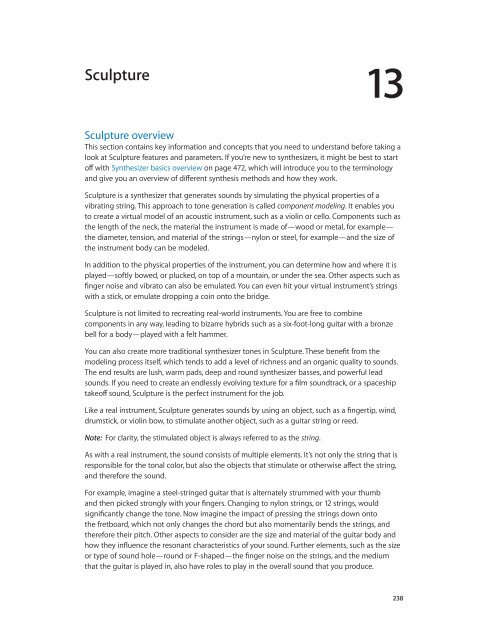Apple MainStage 3 Instruments - MainStage 3 Instruments
Apple MainStage 3 Instruments - MainStage 3 Instruments
Apple MainStage 3 Instruments - MainStage 3 Instruments
Create successful ePaper yourself
Turn your PDF publications into a flip-book with our unique Google optimized e-Paper software.
Sculpture<br />
13<br />
Sculpture overview<br />
This section contains key information and concepts that you need to understand before taking a<br />
look at Sculpture features and parameters. If you’re new to synthesizers, it might be best to start<br />
off with Synthesizer basics overview on page 472, which will introduce you to the terminology<br />
and give you an overview of different synthesis methods and how they work.<br />
Sculpture is a synthesizer that generates sounds by simulating the physical properties of a<br />
vibrating string. This approach to tone generation is called component modeling. It enables you<br />
to create a virtual model of an acoustic instrument, such as a violin or cello. Components such as<br />
the length of the neck, the material the instrument is made of—wood or metal, for example—<br />
the diameter, tension, and material of the strings—nylon or steel, for example—and the size of<br />
the instrument body can be modeled.<br />
In addition to the physical properties of the instrument, you can determine how and where it is<br />
played—softly bowed, or plucked, on top of a mountain, or under the sea. Other aspects such as<br />
finger noise and vibrato can also be emulated. You can even hit your virtual instrument’s strings<br />
with a stick, or emulate dropping a coin onto the bridge.<br />
Sculpture is not limited to recreating real-world instruments. You are free to combine<br />
components in any way, leading to bizarre hybrids such as a six-foot-long guitar with a bronze<br />
bell for a body—played with a felt hammer.<br />
You can also create more traditional synthesizer tones in Sculpture. These benefit from the<br />
modeling process itself, which tends to add a level of richness and an organic quality to sounds.<br />
The end results are lush, warm pads, deep and round synthesizer basses, and powerful lead<br />
sounds. If you need to create an endlessly evolving texture for a film soundtrack, or a spaceship<br />
takeoff sound, Sculpture is the perfect instrument for the job.<br />
Like a real instrument, Sculpture generates sounds by using an object, such as a fingertip, wind,<br />
drumstick, or violin bow, to stimulate another object, such as a guitar string or reed.<br />
Note: For clarity, the stimulated object is always referred to as the string.<br />
As with a real instrument, the sound consists of multiple elements. It’s not only the string that is<br />
responsible for the tonal color, but also the objects that stimulate or otherwise affect the string,<br />
and therefore the sound.<br />
For example, imagine a steel-stringed guitar that is alternately strummed with your thumb<br />
and then picked strongly with your fingers. Changing to nylon strings, or 12 strings, would<br />
significantly change the tone. Now imagine the impact of pressing the strings down onto<br />
the fretboard, which not only changes the chord but also momentarily bends the strings, and<br />
therefore their pitch. Other aspects to consider are the size and material of the guitar body and<br />
how they influence the resonant characteristics of your sound. Further elements, such as the size<br />
or type of sound hole—round or F-shaped—the finger noise on the strings, and the medium<br />
that the guitar is played in, also have roles to play in the overall sound that you produce.<br />
238
















